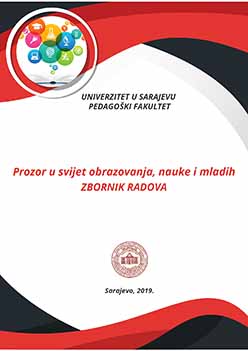KULTURNA BAŠTINA I STRUKTURNI ELEMENTI U UDŽBENICIMA
ZA NASTAVU LIKOVNE KULTURE
CULTURAL HERITAGE AND STRUCTURAL ELEMENTS IN
TEXTBOOKS FOR THE VISUAL ARTS EDUCATION
Author(s): Nela Hasanbegović, Meliha Suljagić
Subject(s): School education, History of Education
Published by: UNIVERZITET U SARAJEVU – PEDAGOŠKI FAKULTET
Keywords: cultural heritage; visual arts education; student teaching; structural elements and textbook as a multimedia source of knowledge;
Summary/Abstract: The aim of the paper is to analyze the contents of a textbooks of visual arts educationwith the aim of questioning the representation of cultural heritage that is the valuabe mirror 115of society and the treasury of the creative potential and the structural elements that are based on it. The textbook as a central didactic-methodical medium has the purpose of stimulating and engaging the student's thought-making activity, facilitating understanding of the core of teaching content to pupils, contributing to the development of personal value systems, divergent opinions and critical thinking, stimulating self-actualization, freedom of expression and design of creative personality components. The theoretical starting point of the work is based on the theory of cognitive development of L. S. Vigotsky emphasizes the importance of the cultural environment for the development of social interaction between the individual and the social environment and the constructivist theory of J. S. Bruner that the learning process is interpreted as a constructive and situational process using the teaching strategies provide research, reflection and practical activity of the student. The research method of theoretical analysis was used to collect content data that teaches students about Bosnia and Herzegovina's cultural heritage in textbooks of visual arts education. Data were collected on a sample of textbooks from the fifth to the ninth grade of elementary school. For the purpose of data collection, a protocol was used for qualitative analysis of the contents of the textbook of visual arts education. Descriptive analysis of collected data has shown that textbooks, in relation to the class and publisher, interpret differently the contents aimed at teaching students about Bosnia and Herzegovina's cultural heritage, in a way that individual textbooks offer richer and more contentable texts and tasks through thought and practical the work of students teaches the Bosnian cultural heritage.
Book: Prozor u svijet obrazovanja, nauke i mladih
- Page Range: 114-133
- Page Count: 20
- Publication Year: 2019
- Language: Bosnian
- Content File-PDF

